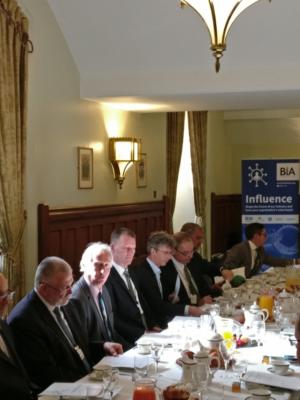A strategy for clean growth: the potential of industrial biotech
The following guest blog is from Dr Jen Vanderhoven, Senior Project Manager for FUJIFILM Diosynth Biotechnologies, and Dr Mark Corbett, Network Manager for BIOCATNET, a BBSRC Network in Industrial Biotechnology and Bioenergy.

Yesterday, the Industrial Biotechnology Leadership Forum (IBLF) launched the new “National Industrial Biotechnology Strategy to 2030” at an event in Parliament, organised by the BIA and hosted by Daniel Zeichner MP. But in a time of seemingly endless strategies – the Industrial Strategy, the Life Sciences Industrial Strategy, the Bioeconomy Strategy –why the need for yet another one?
The potential and the problem(s)
Well, we’re glad you asked. First of all, the current global carbon-based economy is environmentally unsustainable. Addressing this challenge by generating clean growth and reducing waste requires innovative solutions and science-driven technologies.
Industrial biotech (IB) is at the forefront of these technologies. By using biological resources for producing and processing materials, chemicals and energy, IB reduces the environmental impact of production whilst delivering increased economic growth. The sector currently employs 14,000 people in the UK and generates £3.7bn in revenue, with the potential to disrupt international markets worth over $34bn.
Secondly, the UK’s IB sector is well-placed to lead this global shift towards clean growth technologies. The UK’s world-class academic base and thriving life science ecosystem produce promising and exciting research. However, much in other areas of science, commercialisation of that research is lagging behind.
Thirdly, despite its potential, IB’s vast applications means that it struggles to establish itself as a brand. This lack of communication problem is increased by a historical lack of coordination of IB efforts in the UK, where impact of the sector risks being blunted by duplicated efforts, funding gaps, and a lack of high profile success stories.
The aim and the actions
The IB Strategy aims to boost the commercialisation of promising academic research and promote the sector with a consistent community voice, with the long-term aim of making the UK a global player in the global shift towards clean growth.
We have written the Strategy under the guidance of the IBLF and the document is promoted in partnership with the BIA. The Strategy will be implemented in three phases with actions across seven themes:
- External environment – to achieve consensus on a consistent long-term policy landscape that supports industrial biotech
- Funding and access to finance – leading to a supportive financial environment that recognises the potential of IB for driving growth and innovation
- Infrastructure and regional footprint – ensuring that industrial biotech is a major contributor to clean economic growth across all of the UK
- Trade, investment and commercialisation – positioning the UK as an international industrial biotech innovation and commercialisation hub
- Regulations and standards – making certain that UK frameworks are recognised as robust and support risk aware innovation
- Skills – fostering the skills required by industry to make sure that the industrial biotech sector is recognised as an attractive career option
- Communication – promoting one IB community voice, with consistent clear messages, where wider society is well informed and supportive of Responsible Research and Innovation in industrial biotech
These actions aim to place IB at the core the UK Industrial Strategy and the Bioeconomy Strategy. The breakfast brought together stakeholders from industry, academia and policymakers to discuss how the potential of IB may be realised.
The support and the future
Several MPs turned up to show their support, including the host Daniel Zeichner MP, David Drew MP, Barry Gardiner MP, Rachael Maskell MP, and Sandy Martin MP.

Sandy Martin MP, member of Environment, Food and Rural Affairs Select Committee, asked whether, given initiatives such as the ‘Sugar Tax’, aimed at reducing the use of sugars in foods and beverages in order to tackle obesity, the committee should launch an inquiry into the repurposing of sugar feedstocks for bio-based production.
David Drew MP, Labour’s Shadow Minister for Farming and Rural Communities, welcomed the IB Strategy and highlighted that Government and industry must work together to strike the right balance between regulations, bans, taxes, and incentives to bring about the shift towards clean growth technologies.
Daniel Zeichner, MP for Cambridge, stressed that world-leading science relies on access to the best talent from around the world and that the Government and Parliament must recognise this in upcoming debates on the UK’s future immigration system.
Paul Mines, CEO of Biome Bioplastics, spoke about the bioplastics his company are developing to challenge the prevalence of non-degradable oil-based bioplastics. Tim Fell, CEO of Synthace and chair of BIA’s Engineering Biology Advisory Committee (EBAC) highlighted the close relationship between synthetic biology and IB and that these sectors have tremendous ability to transform the global economy.
The Government and MPs are showing increased interest in these areas – clean growth is one of four “Grand Challenges” under the Industrial Strategy, the Treasury is considering ways to address the single-use plastics through the tax system and MPs debate plastic waste just as much as Brexit (…or maybe not quite as much).
The Strategy sets out a unified long-term vision for UK IB, with detailed actions in the first implementation phase to the end of 2019. We will be working to ensure that IB, through this Strategy, is embedded in the delivery plans for the wider Bioeconomy Strategy when it is published. Key to the success of this will be raising awareness of IB and its potential environmental and economic benefits, amongst industry, policymakers, and wider society.
The press release for the launch is available here and the full Strategy is available on BIA’s website.
.png)
.png)